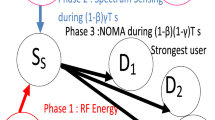Abstract
With the development of self-interference suppression techniques, full-duplex (FD) communication is expected to double the spectrum efficiency (SE). In FD based cognitive radio (CR), the secondary users (SUs) can perform spectrum sensing and data transmission simultaneously, with the goal of achieving better sensing performance or higher throughput for the SUs. Another key performance metric in fifth-generation (5G) wireless networks, energy efficiency (EE), has attracted more and more attention recently. The radio frequency (RF) energy harvesting (EH) technique is proposed to prolong the battery lifetime of low-power communication devices. In this paper, we are interested in the full-duplex CR with energy harvesting. We consider that the SUs can harvest RF energy from the PU and recycle part of its own energy when the secondary data transmission is conducted. The EE of the CR system is defined as the ratio of the average SE over the average power consumption. The system parameters, including the sensing thresholds and the secondary transmit power are optimized to maximize the EE under the constraint that the primary user (PU) is sufficiently protected. Finally, the simulation results are presented to show the outperformance of the proposed FD-EH scheme.




Similar content being viewed by others
References
Cheng, W., Zhang, H., Liang, L., Jing, H., & Li, Z. (2018). Orbital-angular-momentum embedded massive MIMO: Achieving multiplicative spectrum-efficiency for mmWave communication. IEEE Access, 6, 2732–2745.
Towhidlou, V., & Shikh-Bahaei, M. (2018). Adaptive full-duplex communications in cognitive radio networks. IEEE Transactions on Vehicular Technology, 67(9), 8386–8395.
Amjad, M., Akhtar, F., Rehmani, M. H., Reisslein, M., & Umer, T. (2017). Full-duplex communication in cognitive radio networks: A survey. IEEE Communications Surveys and Tutorials, 19(4), 2158–2191.
Zhang, R., Chen, H., Yeoh, P. L., Li, Y., & Vucetic, B. (2017). Full-duplex cooperative cognitive radio networks with wireless energy harvesting. In Proceeding of IEEE international conference on communications (ICC) (pp. 1–6).
Sharma, S. K., Bogale, T. E., Le, L. B., Chatzinotas, S., Wang, X., & Ottersten, B. (2018). Dynamic spectrum sharing in 5G wireless networks with full-duplex technology: Recent advances and research challenges. IEEE Communications Surveys and Tutorials, 20(1), 674–707.
Pratibha, Li K. H., & Teh, K. C. (2017). Optimal spectrum access and energy supply for cognitive radio systems with opportunistic RF energy harvesting. IEEE Transactions on Vehicular Technology, 66(8), 7114–7122.
Bayat, A., & Aissa, S. (2018). Full-duplex cognitive radio with asynchronous energy-efficient sensing. IEEE Transactions on Wireless Communications, 17(2), 1066–1080.
Li, H., Xu, J., Zhang, R., & Cui, S. (2015). A general utility optimization framework for energy-harvesting-based wireless communications. IEEE Communications Magazine, 53(4), 79–85.
Liang, Y.-C., Chen, K. C., Li, G. Y., & Mahonen, P. (2011). Cognitive radio networking and communications: An overview. IEEE Transactions on Vehicular Technology, 60(7), 3386–3407.
Jiang, C., Beaulieu, N. C., Zhang, L., Ren, Y., Peng, M., & Chen, H.-H. (2015). Cognitive radio networks with asynchronous spectrum sensing and access. IEEE Network, 29(3), 88–95.
Cheng, W., Zhang, X., & Zhang, H. (2011). Imperfect full duplex spectrum sensing in cognitive radio networks. In Proceeding of 3rd ACM workshop on cognitive radio networks (pp. 1–6).
Liao, Y., Wang, T., Song, L., & Jiao, B. (2014). Cooperative spectrum sensing for full-duplex cognitive radio networks. In Proceeding of IEEE international conference on communication systems (pp. 56–60).
Cheng, W., Zhang, X., & Zhang, H. (2015). Full-duplex spectrum-sensing and MAC-protocol for multichannel nontime-slotted cognitive radio networks. IEEE Journal on Selected Areas in Communications, 33(5), 820–831.
Shafie, A. E., Ashour, M., Khattab, T., & Mohamed, A. (2015). On spectrum sharing between energy harvesting cognitive radio users and primary users. In Proceeding of international conference on computing, networking and communications (pp. 214–220).
Zhang, Y., Han, W., Li, D., Zhang, P., & Cui, S. (2015). Power versus spectrum 2-D sensing in energy harvesting cognitive radio networks. IEEE Transactions on Signal Processing, 63(23), 6200–6212.
Pratibha, M., Li, K. H., & Teh, K. C. (2016). Channel selection in multichannel cognitive radio systems employing RF energy harvesting. IEEE Transactions on Vehicular Technology, 65(1), 457–462.
Liao, Y., Wang, T., Song, L., & Han, Z. (2014). Listen-and-talk: full-duplex cognitive radio networks. In Proceeding of IEEE global communications conference (pp. 3068–3073).
Peh, E. C. Y., Liang, Y.-C., Guan, Y. L., & Zeng, Y. (2010). Cooperative spectrum sensing in cognitive radio networks with weighted decision fusion schemes. IEEE Transactions on Wireless Communications, 9(12), 3838–3847.
Shi, Z., Teh, K. C., & Li, K. H. (2013). Energy-efficient joint design of sensing and transmission durations for protection of primary user in cognitive radio systems. IEEE Communications Letters, 17(3), 565–568.
Chapra, Steven C., & Canale, Raymond P. (2010). Numerical methods for engineers (6th ed.). New York: McGraw-Hill.
Acknowledgements
This work is supported by National Postdoctoral Program for Innovative Talents (No. BX201700108), Natural Science Foundation of Shanxi Province of China (No. 2018JQ6042), China Postdoctoral Science Foundation on the 63th grant program, and the National Natural Science Foundation of China (Grant No. 61671475, Grant No. 61901509, Grant No. 61571460).
Author information
Authors and Affiliations
Corresponding author
Additional information
Publisher's Note
Springer Nature remains neutral with regard to jurisdictional claims in published maps and institutional affiliations.
Rights and permissions
About this article
Cite this article
Hu, H., Da, X., Zhang, H. et al. Full-Duplex Cognitive Radio with RF Energy Harvesting. Wireless Pers Commun 111, 853–865 (2020). https://doi.org/10.1007/s11277-019-06889-8
Published:
Issue Date:
DOI: https://doi.org/10.1007/s11277-019-06889-8




